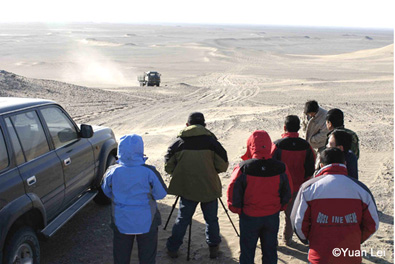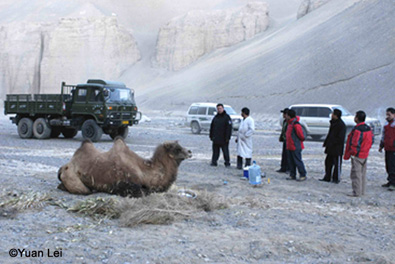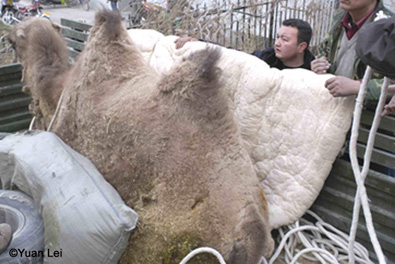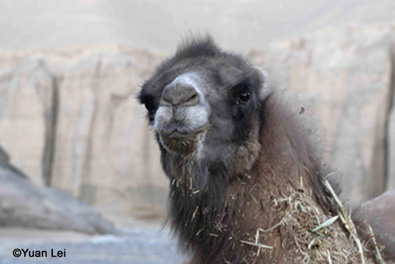On Christmas Eve, the EDGE team received news from Yuan Lei, our Chinese Bactrian Camel EDGE Fellow about his amazing attempt to rescue an injured wild Bactrian camel thousands of kilometres away. Even though this was not part of his EDGE funded work, Yuan Lei could not stand by and do nothing when he learnt about the camel. Here is what he sent:
On the 4th December 2007, a stationmaster of the Bazhou substation of Lop Nur Wild Camel National Nature Reserve reported to the leader of the reserve Mr, Meng Jianying. He said they found a wild camel wounded at Qiashikan Sayi valley, north of Arjin mountain during a routine patrol of the area. The wild camel was a female camel and had a wounded back leg with a possible bone fracture. We suspected it had fallen down from the hill. This wounded wild camel was 300km far from Ruoqiang county.
After we knew this news, Mr, Meng made decision to rescue this wild camel immediately, so we made a rescue plan. Firstly, we arranged enough people in order for us to move the heavy camel onto the truck. We then arranged a truck to help us with our rescue action which could carry the heavy wild camel back to Urumqi. We then planned our rescue route and because we were too far away from the wounded wild camel, we arranged for supplies from the Bazhou substation to go to the valley to care for the wounded wild camel together with Ruoqiang’s two vets. These two vets started one day early before us. Finally we had to think about how to cure and feed the wild camel once we had rescued it. Because we do not have building and doctor to cure and feed it, we contacted to the Tianshan Zoo and they agreed to help us. The zoo had a building and a vet that could help feed and cure the wounded camel.
On the morning of 5th of December we started our journey and stayed at Kurle city that night.The next day we arrived at Ruoqiang county at noon. We prepared more equipment for our rescue like rope, wood, wood block, water and food for wild camel.Early in the morning of the 7th December we set off in the dark. It was a very difficult drive. After 11 hours, we past Gobi, sand desert and valley, and finally arrived at the wounded wild camel in the Qiashikan Sayi valley. We were very happy and glad to see the wild camel was still alive.
The vets had taken care of it very carefully. The vet prepared an injection of penicillin for the wild camel and gave little water and grass to her.
Then we 14 peoples try to our best to carry her to the truck. The wild camel was so heavy that it was extremely difficult to move her on to the truck. After 3 hours we had her safely on the truck and at 10 o’clock that night, we began our non-stop journey back to Ruoqiang with the wild camel.
On the 8th December we drove the whole night and we arrived at Ruoqiang at 1 o’clock at noon. Everybody got short rest and after some food, we continued to start to Kurle city at 6 o’clock that afternoon.Early the next morning at 2 o’clock, we received some bad news.The wild camel had a problem. Her abdomen was full of the air and severely enlarged. Our vet suggested we contact as many people as possible with knowledge of camels so we could all help to cure this animal together.Sadly, the wild camel died after long time wounded. All of us were very sadly and at 4 o’clock in the morning we arrived at Kurle.
When we came back to Urumqi we contacted people to help us preserve the remains of the camel. Two specimens were taken: one of the dead wild camel’s skin and also specimens of bone. Despite our best efforts the wild camel did not survive our rescue mission. However the death of this animal was not for nothing, during this attempt we obtain many experience and we will do better if any wildlife need to be rescued at any time in the future. The skin and bone from the camel can be used to show the public and give good education to know what wild camel are and why we need to protect them.




